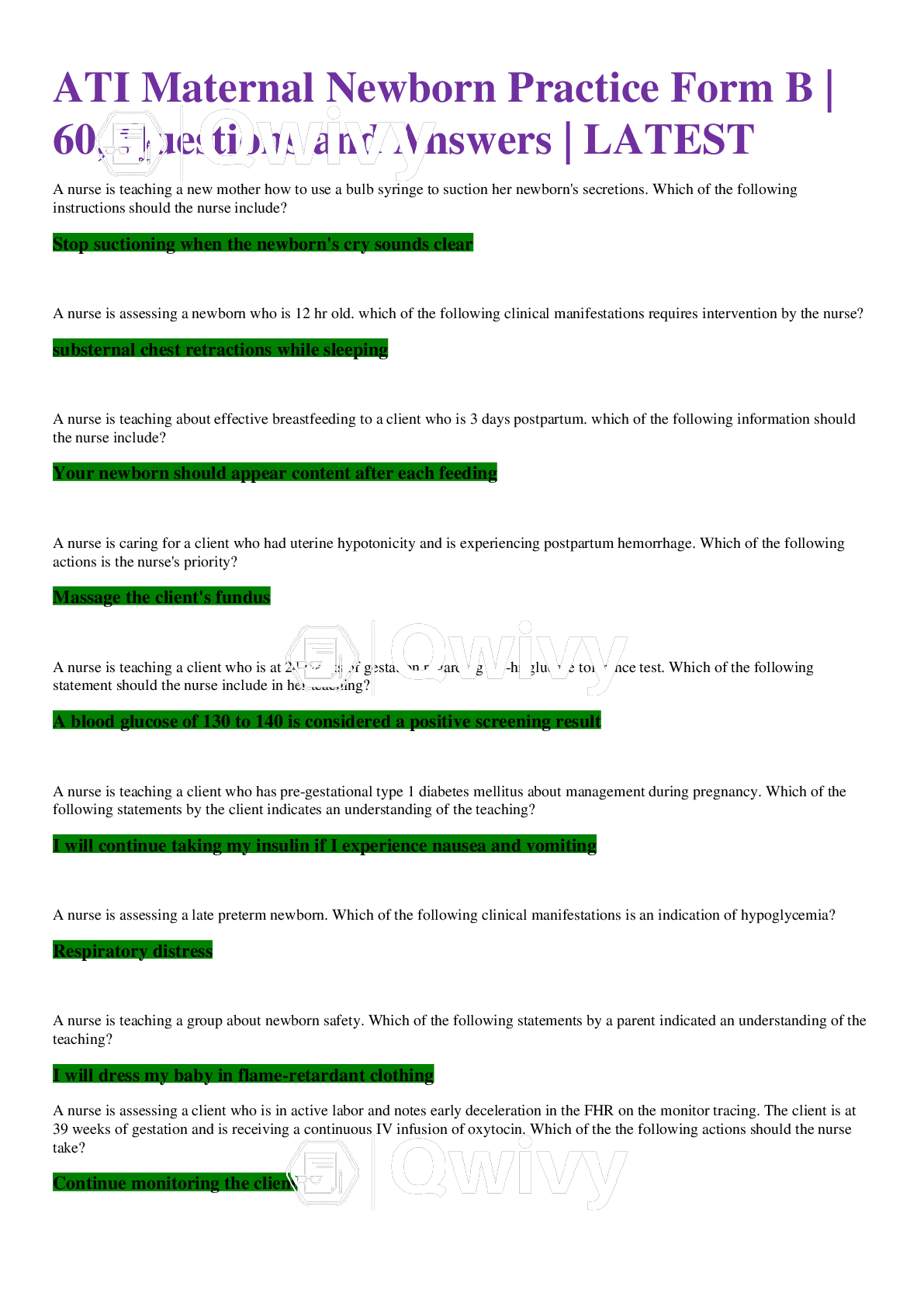
ATI Med Surg test Latest Verified Questions and all Correct Answers with Explanations Managements
of Patients with Burn Injury 100% Correct Answers, Download to Score A
1. A patient is brought to the emergency department from the site of a chemical fire, where he
suffered a burn that involves the epidermis, dermis, and the muscle and bone of the right arm. On
inspection, the skin appears charred. Based on these assessment findings, what is the depth of the burn
on the patients arm?
A) Superficial partial-thickness
B) Deep partial-thickness
C) Full partial-thickness
D) Full-thickness
Ans: D
Feedback:
A full-thickness burn involves total destruction of the epidermis and dermis and, in some cases,
underlying tissue as well. Wound color ranges widely from white to red, brown, or black. The burned
area is painless because the nerve fibers are destroyed. The wound can appear leathery; hair follicles
and sweat glands are destroyed. Edema may also be present. Superficial partial-thickness burns involve
the epidermis and possibly a portion of the dermis; the patient will experience pain that is soothed by
cooling. Deep partial-thickness burns involve the epidermis, upper dermis, and portion of the deeper
dermis; the patient will complain of pain and sensitivity to cold air. Full partial thickness is not a depth of
burn.
2. The current phase of a patients treatment for a burn injury prioritizes wound care, nutritional
support, and prevention of complications such as infection. Based on these care priorities, the patient is
in what phase of burn care?
A) Emergent
B) Immediate resuscitative
C) Acute
D) Rehabilitation
Ans: C
Feedback:
The acute or intermediate phase of burn care follows the emergent/resuscitative phase and begins 48 to
72 hours after the burn injury. During this phase, attention is directed toward continued assessment and
maintenance of respiratory and circulatory status, fluid and electrolyte balance, and gastrointestinal
function. Infection prevention, burn wound care (i.e., wound cleaning, topical antibacterial therapy,
wound dressing, dressing changes, wound dbridement, and wound grafting), pain management, and
nutritional support are priorities at this stage. Priorities during the emergent or immediate resuscitative
phase include first aid, prevention of shock and respiratory distress, detection and treatment of
concomitant injuries, and initial wound assessment and care. The priorities during the rehabilitation
phase include prevention of scars and contractures, rehabilitation, functional and cosmetic
reconstruction, and psychosocial counseling.
3. A patient in the emergent/resuscitative phase of a burn injury has had blood work and arterial
blood gases drawn. Upon analysis of the patients laboratory studies, the nurse will expect the results to
indicate what?
A) Hyperkalemia, hyponatremia, elevated hematocrit, and metabolic acidosis
B) Hypokalemia, hypernatremia, decreased hematocrit, and metabolic acidosis
C) Hyperkalemia, hypernatremia, decreased hematocrit, and metabolic alkalosis
D) Hypokalemia, hyponatremia, elevated hematocrit, and metabolic alkalosis
Ans: A
Feedback:
Fluid and electrolyte changes in the emergent/resuscitative phase of a burn injury include hyperkalemia
related to the release of potassium into the extracellular fluid, hyponatremia from large amounts of
sodium lost in trapped edema fluid, hemoconcentration that leads to an increased hematocrit, and loss
of bicarbonate ions that results in metabolic acidosis.
4. A patient has experienced an electrical burn and has developed thick eschar over the burn site.
Which of the following topical antibacterial agents will the nurse expect the physician to order for the
wound?
A) Silver sulfadiazine 1% (Silvadene) water-soluble cream
B) Mafenide acetate 10% (Sulfamylon) hydrophilic-based cream
C) Silver nitrate 0.5% aqueous solution
D) Acticoat
Ans: B
Feedback:
Mafenide acetate 10% hydrophilic-based cream is the agent of choice when there is a need to penetrate
thick eschar. Silver products do not penetrate eschar; Acticoat is a type of silver dressing.
5. An occupational health nurse is called to the floor of a factory where a worker has sustained a
flash burn to the right arm. The nurse arrives and the flames have been extinguished. The next step is to
cool the burn. How should the nurse cool the burn?
A) Apply ice to the site of the burn for 5 to 10 minutes.
B) Wrap the patients affected extremity in ice until help arrives.
Powered by qwivy(www.qwivy.org)
| Version | latest |
| Category | ATI |
| Included files | |
| Authors | qwivy.com |
| Pages | 25 |
| Language | English |
| Tags | ATI Med Surg test Latest Verified Questions and all Correct Answers with Explanations Managements of Patients with Burn Injury 100% Correct Answers Download to Score A |
| Comments | 0 |
| High resolution | Yes |
| Sales | 0 |









{{ userMessage }}





